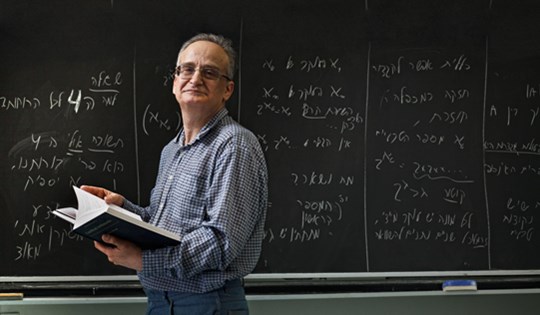The paper of Joel Nagloo, Model Theory and Differential Equations, just published in the Notices of the AMS, is a beautiful portrait of an area of research that encompasses the end of the 19th century, the full 20th century, up to today. It conflates two totally distinct line of thought. The first line is the theory of differential equations, such as the ones that appear in trigonometry (the sine and cosine functions are solutions of the differential equation $y''+y=0$) or in elaborations of trigonometry (Schwarzian or Painlevé equations).
The Painlevé equations, named after the mathematician and statesman Paul Painlevé (1863–1933) — he has been minister of war and prime minister during the French 3rd Republic — are a series of 6 differential equations of the second order, of the form $y''=R(t,y,y')$, where $R$ is a rational function. They are characterized by the Painlevé property that all “movable singularities” of their solutions— those which depend on the initial conditions and are not imposed by the form of the equation— are poles. Painlevé classified these equations: up to computation errors later corrected by Gambier and Fuchs, this gives the following irreducible list of 6 equations, in which the variable is $t$, the unknown is $y$, and the Greek letters $\alpha, \beta,\gamma,\delta$ representing parameters:
- $y''=6y^2+t$
- $y''=2y^3+ty+\alpha$
- $tyy''=t(y')^2-yy'+\delta t+\beta y+\alpha y^2+\gamma ty^4$
- $y y''=\frac12 (y')^2+\beta+2(t^2-\alpha)y^2+4ty^3+\frac32 y^3$
- $y''=(\dfrac1{2y}+\dfrac1{y-1})(y')^2-\dfrac1t y'+\dfrac{(y-1)^2}{t^2} (\alpha y+\beta \dfrac1y)+\gamma\dfrac yt+\delta \dfrac{y(y+1)}{y-1}$
- $y''=\frac12(\dfrac1y+\dfrac1{y-1}+\dfrac1{y-t})(y')^2-(\dfrac1t+\dfrac1{t-1}+\dfrac1{y-t})y'+\dfrac{y(y-1)(y-t)}{t^2(t-1)^2}(\alpha+\beta \frac t{y^2}+\gamma \dfrac{t-1}{(y-1)^2}+\delta\dfrac{t(t-1)}{(y-t)^2}$
By irreducible list, it is meant that all equations satisfying the Painlevé property are reducible to either previously known equations (involving elliptic functions or the Ricatti equations), and that those equations are not. Therefore, the solutions of these equations were classically called “transcendental” because they were generally (meaning except for some particular choices of parameters) not rational functions, nor could be derived by algebraic equations. The basic questions that people want to understand here is how much these functions are transcendental.
In this direction, a 2020 theorem of Joel Nagloo is that if you take $n$ distinct solutions $y_1,\dots, y_n$ of a “generic” Painlevé equation of type III or VI, then there is no (nontrivial) algebraic relation between the $2n$ functions $y_1,\dots,y_n$ and their derivatives $y_1',\dots,y_n'$. Here, generic means that the parameters involved in the differential equation they satisfy are algebraically independent over the field of rational numbers.
With Guy Casale and James Freitag, Joel Nagloo has proved a similar theorem for the third order Schwarzian equations associated with a Fuchsian subgroup $\Gamma$ of $\mathrm{PSL}(2,\mathbf R)$. The situation is more subtle: there are possible algebraic relations, but they are completely classified by Hecke correspondences.
The second line of thought is model theory, an area of mathematics classically attached to mathematical logic that tries to understand the intrinsic properties of mathematical theories, whatever they are. To that aim, they do geometry: they consider “definable subsets”, that is, loci defined (in some object of the considered theory) by the type of equations that the theory affords.
For example, if the theory involves fields only, the object could be a large algebraically closed field (such as the field complex numbers) and the equations are essentially polynomial equations, with the exception that they allow quantifiers, and negations, to define their loci. In fact, in this case, it is a theorem, classically attributed to Chevalley, that quantifiers are not needed — one only gets so-called constructible sets.
Another kind of interesting structure is that of differential fields, in which one has the classical field operations, but also an abstract derivation operator (satisfying the standard rules for derivations). Then, definable sets are essentially differential equations.
What model theory does in general is trying to define ways to categorize the definable subsets. One such important invariant would be an analogue of the Zariski dimension of constructible sets in algebraic geometry: the Morley rank. Roughly, a definable set has Morley rank $0$ if it is finite. It has Morley rank at least $n$ if it admits an infinite family of disjoint definable subsets of Morley rank $\geq n-1$. A particular case of sets of Morley rank $1$ are the strongly minimal definable subsets which are infinite and such that any definable subset of it is finite or cofinite (the complementary set is finite).
More importantly, model theory identifies structural properties of theories that make them “neater”, and this gives rise to an “universe of theories”. As you can see on this “map of the universe” (made by Gabriel Conant), the theory ACF of algebraically closed fields is one of the simplest ones that exists, and recent work in model theory tries to clarify what happens in much more complicated ones, characterized by incredible names or acronyms, strongly minimal, stable, distal, o-minimal, NIP, supersimple, NTP₂…
One of the fundamental results in model theory that emerged in the years 1980-2000 is the theory of Zariski geometries and Boris Zilber's “trichotomy principle” that indicates that 1-dimensional (strongly minimal) objects classify in 3 disjoint classes:
- geometrically trivial: there are essentially no other relation between distinct points of that object, beyond the fact that they belong to it. The generic Painlevé equations furnish important examples of this case, but proving strong minimality is the hard step.
- group-like: some algebraic group is hidden in the picture, and constrains all possible relations.
- field-like: this is essentially algebraic geometry over some hidden field.
I must be terse here, stability theory in model theory is an immense area with which I am not enough familiar, and I just insert pictures of three big names in the field, namely Morley, Shelah and Hrushovski:
For more details, and definitely more insight, I refer you to Joel Nagloo's paper quoted above. I also refer you to the Freedom Math Dance blog posts on Model theory and algebraic geometry.




No comments :
Post a Comment